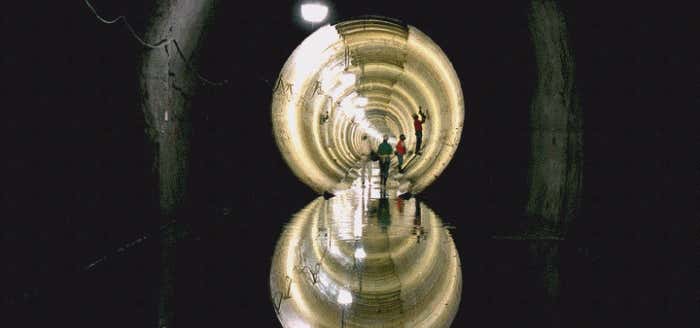“The unfinished remains of the world's largest supercollider.”
This place is on private property. Listing for informational purposes only. Please do not visit without express permission from the land owner. The Superconducting Super Collider (SSC) (also nicknamed the Desertron) was a particle accelerator complex under construction in the vicinity of Waxahachie, Texas, that was set to be the world's largest and most energetic, surpassing the current record held by the Large Hadron Collider. Its planned ring circumference was 87.1 kilometres (54.1 mi) with an energy of 20 TeV per proton. The project's director was Roy Schwitters, a physicist at the University of Texas at Austin. Dr. Louis Ianniello served as its first Project Director for 15 months. The project was cancelled in 1993 due to budget problems. During the design and the first construction stage, a heated debate ensued about the high cost of the project. In 1987, Congress was told the project could be completed for $4.4 billion, and it gained the enthusiastic support of Speaker Jim Wright of nearby Fort Worth, Texas. A recurring argument was the contrast with NASA's contribution to the International Space Station (ISS), a similar dollar amount. Critics of the project (Congressmen representing other US states and scientists working in non-SSC fields who felt the money would be better spent on their own fields) argued that the US could not afford both of them. Early in 1993 a group supported by funds from project contractors organized a public relations campaign to lobby Congress directly, but in June, the non-profit Project on Government Oversight released a draft audit report by the Department of Energy's Inspector General heavily criticizing the Super Collider for its high costs and poor management by officials in charge of it. A high-level schematic of the lab landscape during the final planning phases. Congress officially canceled the project October 21, 1993 after $2 billion had been spent. Many factors contributed to the cancellation: rising cost estimates; poor management by physicists and Department of Energy officials; the end of the need to prove the supremacy of American science with the collapse of the Soviet Union; belief that many smaller scientific experiments of equal merit could be funded for the same cost; Congress's desire to generally reduce spending; the reluctance of Texas Governor Ann Richards; and President Bill Clinton's initial lack of support for a project begun during the administrations of Richards's predecessor, Bill Clements, and Clinton's predecessors, Ronald Reagan and George H. W. Bush. However, in 1993, Clinton tried to prevent the cancellation by asking Congress to continue "to support this important and challenging effort" through completion because "abandoning the SSC at this point would signal that the United States is compromising its position of leadership in basic science". The SSC's planned collision energy of 40 TeV is almost three times the current 14 TeV of its European counterpart, the Large Hadron Collider (LHC) at CERN in Geneva. The SSC cost was due largely to the massive civil engineering project of digging a huge tunnel underground. The LHC, in contrast, took over the pre-existing engineering infrastructure and 27 km long underground cavern of the Large Electron-Positron Collider, and used innovative magnet designs to bend the higher energy particles into the available tunnel. The LHC eventually cost the equivalent of about 5 billion US dollars to build.. After the project was canceled, the main site was deeded to Ellis County, Texas, and the county tried numerous times to sell the property. The property was finally sold in August 2006 to an investment group led by the late J.B. Hunt. Collider Data Center has contracted with GVA Cawley to market the site as a data center. Chemical company Magnablend bought the property and facilities in 2012, against some opposition from the local community.
No (known) evidence remains of the SCC, except for the entryway, AKA: "The Texas Doors." The project was never completed, the tunnels were flooded, and it is now actively operating as a chemical company.
I've driven past it and the above-ground architecture is unremarkable. It's hard to believe we blew around 5 BILLION tax-dollars on something that you would never guess ever existed! The current owner is a company called Magnablend.
Don't waste your time on this one, its glory days are long gone.
This place was not "flooded", can you tell me where drought stricken Texas got 14 miles worth of WATER?
That tunnel has been connected with a whole government network of tunnels. It is active and there is another opening to it if you know where to look. Highly guarded.
If it were full of water it would be a reservoir for Waxahachie's water supply. ITS NOT. They are still having to purify the dank pond skum water out of the tiny city "lake".
how much electricity is powered to this place?
NOT abandoned. Don't try exploring this place, it's active lmao.
Be the first to add a review to the Abandoned Superconducting Supercollider.
Hours
Problem with this listing? Let us know.
Has RV parking changed? Let us know.
-
Parking
-
Pets Allowed
-
Restrooms
-
Wifi
-
Wheelchair Accessible
-
Credit Cards Accepted
Nearby Hotels
Related Trip Guides
The top things to do on an I-40 road trip
- 35 Places
- 49:44
- 2,851 mi
The top things to do on an I-10 road trip
- 55 Places
- 56:13
- 3,026 mi





/-96.8483311,32.3865312,14/300x172@2x?access_token=pk.eyJ1Ijoicm9hZHRyaXBwZXJzIiwiYSI6ImNsdjQ5N2VtZDA2bW8ycW13ZHAxeGhjbjkifQ.UIccpoAxc7g3BAuK4s9vjg)